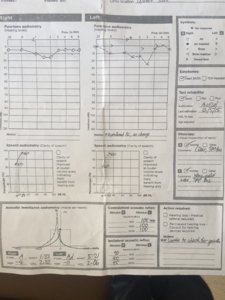kinda weird how i have a sharp dip in 1 ear only
Are you referring to the 3 kHz dip in the left ear?
im 99% sure mine was caused by headphones
Do you have any previous audiogram to compare to?
How old is this diagram?
I had a 30 dB dip at exactly 6 kHz. After 2 months, I took another test (at a different audiologist) and it showed 15 dB dip at 6 kHz. As if it had improved! But I think it's my brain that has compensated for the loss by increasing central gain.
Here's another "cool" fact, I was previously exposed to a sudden, loud "PEEEEEP" noise coming out of my computer sound card, at around 6 kHz. It's interesting because my tinnitus frequency is around 6 kHz.
So I don't have to relate my tinnitus frequency to an audiogram, I can relate it to the sudden noise I was exposed to by the stupid sound card, caused by some driver issue with the "latest and greatest" Windows 10.
Here's another fact! I was wearing earphones! I regret that now. But can't do anything about it, other than stop using earphones and headphones. I suggest you do the same.
Knowing what I know now, I can tell you that the audiogram is inadequate to assess inner ear damage. It's a subjective test and the brain plays its own tricks. It's good for detecting conductive hearing loss though, and middle ear pressure problems.
You seem to have normal middle ear pressure. Note that you have type A tympanogram. But one of your ears is little bit off, but not by much. I don't know what "Ad" tympanogram is. Near normal? I don't know.
Have you discussed the test results with your doctor or audiologist? You should discuss it with him or her.
It looks like you may have some conductive problem in the left ear. You can see that the bone conduction worked much better than air conduction. This may be caused by any pressure problem in the middle ear.
That's as much as I can tell you. It's not clear to me what is left ear and what is right ear tympanograf. If it's the left ear tympanograf that's off by a little, it may explain the air conduction fluctuation on the audiogram for the left ear.
These test results are not easy to read. Not only do you need to know how to read them, but this is one of those that is drawn by hand. The doctor or audiologist uses a printed template and plots the graph. So this can also depend on the penmanship of the doctor. Every place I have been to had these things plotted and printed by the computer. It makes it much easier to read. But this is not too bad either, but you should perhaps discuss it with the doctor.
I used to be obsessed by these audiograms!

That's why I know how to read them. But as I said, they don't tell you much about the health of your inner ear.
Why do you think your headphones have caused your tinnitus?

 Member
Member
 Manager
Manager But I'm sure you can find it if you google his name.
But I'm sure you can find it if you google his name. 
 Always using these analogies! I love doing that as well. It makes it dead simple for people to understand complex problems. But it takes a lot of insight into the subject for you to be able to explain it well to others.
Always using these analogies! I love doing that as well. It makes it dead simple for people to understand complex problems. But it takes a lot of insight into the subject for you to be able to explain it well to others. That's why I know how to read them. But as I said, they don't tell you much about the health of your inner ear.
That's why I know how to read them. But as I said, they don't tell you much about the health of your inner ear.
